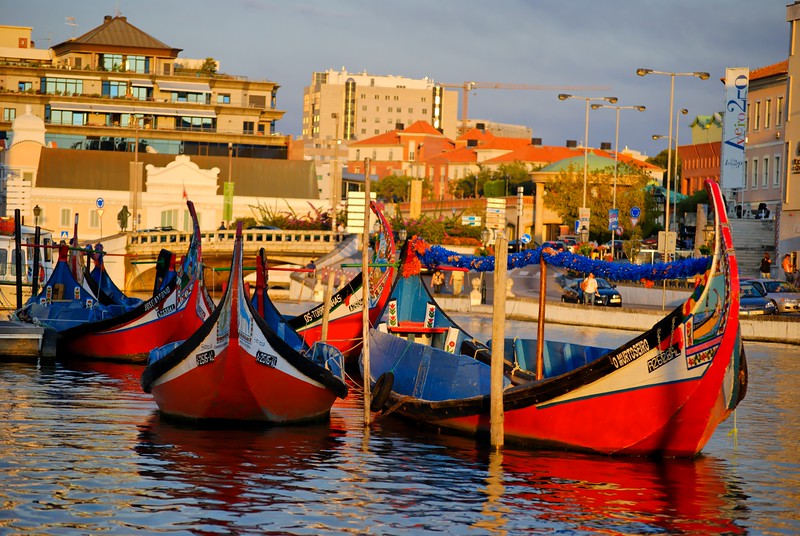The city

Central Canal

Art Nouveau at Aveiro
Aveiro is surrounded by salt-flats, beaches, and lagoons. It is crossed by three canals spanned by low-arched bridges, and is divided into two parts by the Central Canal. The canal itself is lined with fine Art Nouveau buildings and beautifully painted gondola-like boats known as moliceiros. These were once mainly used to collect seaweed, but now transport tourists down the canal.

Moliceiros
Once a big seaport, Aveiro lies in a region of valleys cut by mountains and fertile lagoon plains. In the old quarter, tourists can see the quaint whitewashed houses of the fishermen and visit, early in the morning, the Mercado do Peixe (Fish Market), once an auction of the fish caught during the night.

Mercado do Peixe
Facing the Atlantic nearby are the sandy beaches of Barra (with the country’s tallest lighthouse; the second-tallest in Europe and third in the world) and Costa Nova (known for its attractive candy-striped houses). The fine beach of São Jacinto lies close to woodland and the São Jacinto Dunes Natural Reserve, with well-preserved dunes and varied fauna and flora.

Barra

Costa Nova

São Jacinto Dunes Natural Reserve
Those who appreciate good food can taste the delicious eel stew and a variety of sea and lagoon fish soups. But Aveiro is especially known for its sweets: the most famous is ovos moles (soft eggs), sweetened egg yolk in candied casings shaped like fish or barrels.

Ovos Moles
Restaurants
The university
Created in 1973, the University of Aveiro quickly became one of the most dynamic and innovative universities in Portugal. Now a public foundation under private law, it continues to develop and implement its mission to provide undergraduate and postgraduate education, to generate research and promote cooperation with society. The University campus offers a unique importunity to have a glimpse at the works of some of Portugal most iconic architects, such as Pritzker laureates Siza Vieira and Souto de Moura.

The library of the University of Aveiro, designed by Architect Álvaro Siza Vieira
Attended by about 17,000 students on undergraduate and postgraduate programmes, 9% of which are international students, the UA has achieved a significant position amongst higher education institutions in Portugal being one of the top universities regarding the quality of its infrastructures, the strength of its research and the excellence of its staff. The British Times Higher Education Ranking considered the UA one of the best 100 universities (position 51-75) in Europe.
Excellence in research is one of the hallmarks of the University: 19 of its 20 research units were classified as Very good or Excellent by international panels under the sponsorship of the Portuguese National Science Foundation in its most recent round of assessments. Four of these units carry the label of Associate Laboratory, a distinction attributed by the Portuguese Government to research institutions of sustained and exceptional merit.